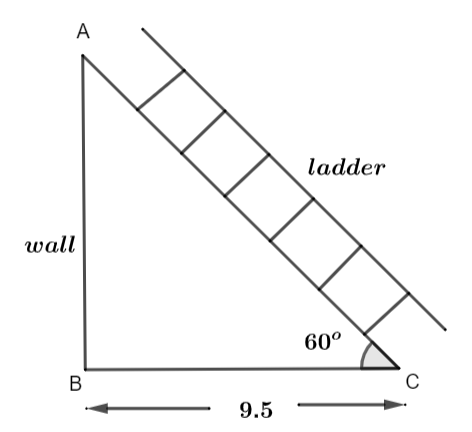Question
Question: The angle of elevation of a ladder against a wall is \({{60}^{\circ }}\) and the foot of the ladder ...
The angle of elevation of a ladder against a wall is 60∘ and the foot of the ladder is 9.5 meter away from the wall. Find the length of the ladder.
Solution
Hint:First, we will draw the figure with the details given to us. Then, we will use the formula of trigonometric ratios with angles to solve the question. The formula is given by cos(θ)=HypotenuseBase.
Complete step-by-step answer:
The diagram for the question is shown below.

Clearly, AC represents the ladder which is standing against the wall AB. The distance of the bottom of the ladder and the wall is 9.5 meters. We are supposed to find the value of AC that is the length of the ladder.
For that we will apply the trigonometric formula given by cos(θ)=HypotenuseBase. Since, the angle of elevation of a ladder against a wall is 60∘ therefore the angle ∠ACB=60∘.
Now, we use the formula cos(θ)=HypotenuseBase. As we know that the base is BC and the hypotenuse is AC.
Thus, we get cos(60∘)=ACBC where θ=60∘. Since, BC = 9.5 meters.
Therefore, we have cos(60∘)=AC9.5. Now, we will substitute the value of cos(60∘)=21. This result into, 21=AC9.5⇒AC=9.5×2⇒AC=19
Hence, the height of the ladder is 19 meters.
Note: We could have used the trigonometric formula tan(θ)=Baseperpendicular in the question. Therefore, we get tan(60∘)=BCAB. Since, tan(60∘)=3 so, we have 3=BCAB. Also we can substitute BC = 9.5 meters therefore, we have
3=9.5AB⇒9.5AB=3⇒AB=3×9.5...(iii)
And we have applied sin(θ)=HypotenusePerpendicular. Therefore, we have sin(60∘)=ACAB. Now, we will substitute the value of sin(60∘)=23 therefore, we have
23=ACAB⇒AB=23×AC...(iv)
Now, we will equate the equations (iii) and (iv) therefore, we have
3×9.5=23×AC⇒3×9.5×32=AC⇒AC=3×9.5×32
After cancelling the 3 we get
AC=3×9.5×32⇒AC=9.5×2⇒AC=19
Hence, the required value of the ladder is 19 meters.
